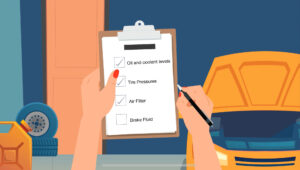Day to day, we rely on our tires to keep us planted on the ground with the sole purpose to get us from Point A to Point B. But have you ever thought about what happens to tires when they are pushed to the limit, let’s say for 24 hours?
The beauty of sports car racing is that it’s essentially the same as our daily driving, just at an entirely new level. Sports car racing series such as the International Motorsports Association (IMSA) – which features everything from BMWs, to Porsches, to Hyundais to Corvettes – aims to take street cars and test the threshold of which they can handle. The first race of the season, the Rolex 24 Hours At Daytona is the perfect example of how cars are pushed the max. One of the most important aspects of this grueling 24 hour endurance race is tires and tire wear.
Mobile Pitstop co-owner, Gabby Chaves will be participating in the annual 24 hour classic at the end of the month onboard the No. 36 Andretti Autosport LMP3 car. This year’s 24 hour race will mark Chaves fourth time participating in the event.
“The Rolex 24 Hours is a very different kind of race compared to a sprint race,” said Chaves. “Sprint races are typically an hour or two and you are driving at 100% every single lap. In a 24 hour race there are a lot more variables – you have to take care of the car and make sure you are not wearing too hard on the components of the car. You’re dealing with more factors like strategy, fuel, caution periods, so you have to be a lot more dynamic in a 24 hour race.”
The Basics: Race Tires vs. Street Tires
To start with the basics there are two types of tires in sports car racing: ‘slicks’ and rain tires. Slicks are used in dry conditions and rain tires are, well, used in wet conditions. Unlike our typical street tires that are on our daily drivers, slick tires have no tread on them. With race cars reaching speeds close to 200mph at Daytona International Speedway, it’s important that the maximum amount of tire surface be touching the ground – hence the reason why slick tires don’t feature any tread. Think, more rubber, better grip, more traction.
On the other hand, rain tires will have tread, similar to what we see on our every day tires. The purpose of the tread is to help redirect the moisture that is produced from the track surface to allow for more grip. Without tread in rainy conditions, hydroplaning will likely occur.
Now you may ask why do our street tires have tread if no tread is supposed to allow for more grip? Well, street tires are multi-functional and need to work in both dry and wet conditions (unless you’re changing your tires every time it rains)! Since speeds reached on a street car are much lower than in a race car, treaded tires will last much longer and also function for those rainy days as well.
Tires and 24 Hours of Racing
Now that we have the basics covered let’s get into the importance of tires when running a 24 hour long race.
Just like street tires, they get worn down and the tread begins to fade away. While you may have to change your tires every 40k miles on your street car, race cars can change their tires as quickly as one hour. This is of course because the speeds that a street car are reaching are
significantly different than what race cars are reaching (imagine going 80+ mph around a tight corner).
Veteran tire technician, Reg Schmeiss has worked in Formula 1, DTM, V8 Supercars and currently IMSA and being on tire programs since 1980. Schmeiss explains the “golden rule” of tire management is repeatability and consistency.
“In the long races like the Rolex 24, we cant have 40 sets of tires mounted and ready, so its a bit more complicated to follow along and understand that every set has a different start pressure,” explains Schmeiss. “And the pressure can be based on a temperature change or different driver because each drivers inputs make a difference. Keeping super accurate notes is also very, very important for 24 hours. Trusting your helpers to purge all sets exactly the same is a huge deal for these long races.”
Race tires will begin to show signs of wear after about an hour of racing. Of course those tires will not be sent to the dumpster after that, but rather will be what is called “double-stinted.” With a limited number of tires that teams are allocated for the full 24 hours, teams must reuse or “double stint” the tires. This means that a set of tires that have already been ran 1+ hours, will be put back on the car a second time.
Strategy is important when double-stinting tires because teams and drivers must recognize that a set of double-stinted tires will have far less grip and performance compared to a brand new set of tires. Similar to how you may notice your car sliding around when your tires get older, racers will experience the same feeling on well-used tires.
“From a racers point of view, when your tires begin to wear down it’s an interesting feeling because it happens gradually,” said Chaves. “You can start picking up on the grip loss gradually and then you have to start making very minute adjustments each lap until the end of that tire life or stint. If you were to compare the first or second lap to the last lap of the tire stint then you would have a big noticeable difference – and maybe a couple of seconds per lap. And because of that, that means a lot less braking performance, less cornering performance and a lot less traction on acceleration which is something that you have to adjust for.”
All in all, whether you’re behind the wheel of a high powered sports car or your Honda Civic, tires are one of the most important aspects of driving. Managing tire wear is crucial to safety whether you’re going 200mph on the banks of Daytona International Speedway or 50mph on the the highway. Mobile Pitstop offers tire sales and installation services and they make it a simple process. Head on over the Mobile Pitstop App or to www.mobilepitstopvan.com to figure out which tires will best fit your vehicle.
And if you want to tune into the 60th Running of the Rolex 24 At Daytona, turn on NBC at 1:30pm ET on Saturday January 29th to catch Gabby Chaves and the Andretti Autosport crew take the green flag.
Fast Rolex 24 Tire Facts from Reg:
– Teams are allocated 38 sets of slick racing tires for the Rolex 24
– Rain tires are not limited for each team
– Tire pressures are crucial in racing – 1-2 psi can make the biggest difference on track
– Tires are filled with Nitrogen rather than standard air to reduce the amount of humidity in the tires. Humidity causes the tires to expand which gives inaccurate tire pressure readings.
– Typically doubling stinting tires will occur in the nighttime with cooler temperatures.
– IMSA team tire technicians work hand-in-hand with Michelin tire techs throughout the entire race. Team tire technicians manage any inconsistencies and can request further inspection from Michelin
– At Daytona, the front tires are the key to managing toe and camber





3 thoughts on “Tire Management: Rolex 24 Hours At Daytona”
“Very good blog post. I definitely appreciate this site. Continue the good work!
}” visit the following internet page
I am impressed, I must say. Really seldom do I discovered a blog thats both informative and entertaining, and let me tell you, youve hit the nail on the head. Your post is outstanding; the matter is something that not many people are talking intelligently about. I am really happy that I stumbled across this in my search for something relating to this.
Im very pleased to find this site. I need to to thank you for ones time for this particularly fantastic read!! I definitely really liked every part of it and I have you bookmarked to see new information on your site.